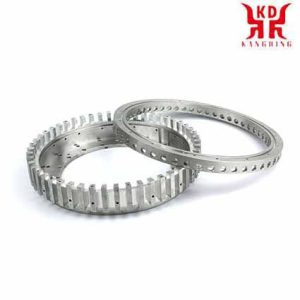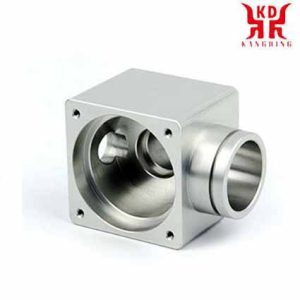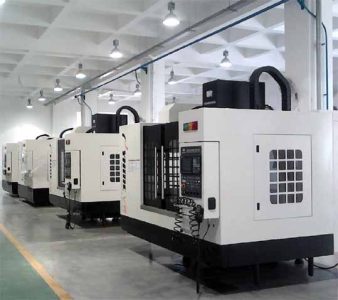Wat is frezen? Wat is het proces van malen? Welke onderdelen kunnen worden bewerkt door CNC-frezen?? Welke precisie kunnen China-freesonderdelen bereiken??

Wat is frezen?
CNC-gefreesde onderdelen
Hoe worden CNC-gefreesde onderdelen vervaardigd?
CNC-gefreesde onderdelen worden op CNC-freesmachines bewerkt met behulp van roterende gereedschappen. Er wordt gebruik gemaakt van CNC-freesmachines met verschillende bewegingsvrijheidsgraden: 3-as, 4-as- en 5-assige freesmachines.
3-asfreesmachines kunnen alleen CNC-gefreesde onderdelen vanuit één toegankelijkheidsrichting bewerken. Ze zijn goedkoper dan de andere soorten freesmachines. 4-asfreesmachines hebben een extra rotatie-as voor het gefreesde onderdeel, bijvoorbeeld voor de productie van spindels en andere spiraalvormige geometrieën. 5-asfreesmachines kunnen CNC-gefreesde onderdelen van alle kanten bewerken, afhankelijk van de klemming, en produceren ook complexe geometrieën.
Met ons leveranciersnetwerk, wij kunnen een breed scala aan CNC-gefreesde onderdelen vervaardigen voor een breed scala aan vereisten.
Wij zijn gespecialiseerd in CNC-bewerkingen, onze automatische prijsberekening wordt voortdurend uitgebreid en omvat momenteel componenten met de volgende eigenschappen.
Frezen bestaat voornamelijk uit het snijden van het materiaal dat wordt bewerkt met een roterend gereedschap met meerdere randen, tanden genoemd, lippen of hardmetalen inzetstukken, die geprogrammeerde voortbewegingen van de werktafel uitvoert in vrijwel elke richting van de drie mogelijke assen waarop de tafel waarop het te bewerken onderdeel is bevestigd, kan worden verplaatst.
Met het toenemende gebruik van numerieke besturingsfreesmachines, the milling operations that can be carried out with this type of machine are increasing, and thus milling has become a multipurpose machining method. The development of the tools has also contributed to create new possibilities of milling in addition to considerably increasing the productivity, quality and accuracy of the operations carried out.
| Our manufacturing options for CNC milled parts
Component dimensions from 2 mm x 2 mm x 2 mm |

cnc-freesonderdelen
Milling tools
De freesgereedschappen kenmerken zich door hun buitendiameter, het aantal tanden, de steek van de tanden (opgevat als de afstand tussen twee opeenvolgende tanden) en het bevestigingssysteem van de frees op de machine.
Soorten frezen
Bij de universele freesmachines met de juiste accessoires of bij de numerieke besturingsfreesmachines kan de volgende planning worden uitgevoerd.
De meest voorkomende toepassing van frezen is vlakfrezen, waarbij vlakke oppervlakken worden beoogd. Voor het vlakfrezen worden doorgaans frezen met verwisselbare hardmetalen wisselplaten gebruikt, er is een zeer gevarieerd bereik van diameters van deze molens en het aantal wisselplaten dat elk bevat freesbevestigingen. Insert manufacturers recommend as a first option the use of round inserts or with 45º angles as an alternative.
Square milling. Square milling is a variant of face milling that consists of leaving perpendicular steps in the part to be machined. Voor deze, square inserts are used that are located in the tool holder in an appropriate way.
Cube Milling. The cubing operation is very common in vertical or horizontal milling machines and consists of preparing the metal dowels or other material such as marble or granite in the appropriate cubic dimensions for subsequent operations. This milling is also done with interchangeable insert face milling cutters.

cnc-freesonderdelen Soorten frezen
Cut milling. Een van de eerste bewerkingen die moeten worden uitgevoerd, bestaat vaak uit het op de bepaalde lengte snijden van de stukken, uitgaande van in de handel verkrijgbare staven en profielen met een grotere lengte.. Bandzagen of freesmachines uitgerust met cilindrische messen worden door elkaar gebruikt voor het industrieel zagen van onderdelen. Wat belangrijk is aan het snijden van boren, is dat ze gemaakt kunnen zijn van snelstaal of hard metaal. Ze worden gekenmerkt doordat ze erg dun zijn (op bevel van 3 mm, ook al kan het variëren), met een grote diameter en zeer fijne tanden. Een voorbeeld van de kenmerken van een cutter zou het volgende zijn: diameter van 200 mm, dikte van 3 mm, diameter van het gat van 32 mm en 128 tanden: Prima 128, Ruw 64.
Recht groeffrezen. Voor het frezen van rechte groeven, Cilindrische frezen met de breedte van de groef worden over het algemeen en vaak gebruikt, om de productie te verhogen, Er zijn meerdere messen op de messenas gemonteerd, waardoor de bewerkingsproductiviteit wordt verhoogd. Het samenstellen van meerdere cilindrische aardbeien wordt een trein aardbeien of samengestelde aardbeien genoemd. Cilindrische boren worden gekenmerkt door drie snijkanten: de voorkant en de twee zijkanten. In de meeste toepassingen worden sneldraaistaalfrezen gebruikt, omdat hardmetalen boren erg duur zijn en daarom alleen in zeer grote producties worden gebruikt.

cnc-freesonderdelen Soorten frezen
Vormgroef.. Er worden boren met de juiste vorm voor de groef gebruikt, die T-vormig kan zijn, zwaluwstaart, enz.
Spiebaangroeven. Cilindrische aardbeien met handvatten, in het jargon bekend als ballerina's, worden gebruikt die zowel in een richting loodrecht op de as als evenwijdig daaraan kunnen snijden.
Frezen bij kopiëren. Round insert profile cutters are used for copy milling in order to be able to carry out machining operations in orographies and profiles of changing faces. There are two types of copy cutters: those with a half ball profile and those with a round or toric edge.
Cavity milling. In this type of operation, it is advisable to carry out a prior drilling and from there and with suitable milling cutters, approach the cavity machining, bearing in mind that the radii of the cavity must be at least 15% greater than the radius of the milling cutter.
Lathe-milling. This type of machining uses circular interpolation in numerical control milling machines and is used for both precision hole turning and external turning. The process combines the rotation of the workpiece and the milling tool, making it possible to achieve a cylindrical surface. This surface can be concentric with respect to the center line of rotation of the part, or it can be eccentric if the milling is moved up or down. With axial displacement it is possible to achieve the required length.
Thread milling. Thread milling requires a milling machine capable of simultaneous helical interpolation in two degrees of freedom: the rotation of the part with respect to the axis of the helix of the thread and the translation of the part in the direction of said axis.
Face milling. It consists of milling that is carried out with cylindrical helical burs that attack the milling operation frontally. More and more fully integral carbide burs are used in numerical control milling machines that allow working at very high speeds.
Gear milling. Gear milling is hardly carried out on universal milling machines using the dividing plate anymore, but is done on special machines called gear hobbing machines and with the use of special milling cutters of the appropriate tooth module.
Drilling, reaming and boring. These operations are usually carried out on numerical control milling machines equipped with a tool magazine and using the appropriate tools for each case.
Mortising. It consists of machining keyways in the holes, for which broaching machines are used or a special accessory that is attached to the universal milling machine head and transforms the rotation movement into an alternative vertical movement.
Ramp milling. It is a common type of milling in the machining of molds that is done either with copier milling machines or with numerical control milling cutters.
Hoe werkt de CNC-freesmachine?
The introduction of computerized numerical control (CNC) has exponentially expanded the applications of industrial machines through the programmable automation of production and the achievement of movements impossible to carry out manually, such as circles, diagonal lines and other more complicated figures that allow the manufacture of parts with highly complex profiles. Dit vertaalt zich ook in de optimalisatie van veel essentiële variabelen van elk productieproces: productiviteit, precisie, veiligheid, snelheid, herhaalbaarheid, flexibiliteit en vermindering van verspilling.
De veelheid aan freesmachines die vandaag de dag bestaan, heeft zich comfortabel uitgebreid tot de proliferatie van hun CNC-uitgeruste collega's. In werkelijkheid, Er zijn ook speciale kits om oude freesmachines om te bouwen tot een CNC-freesmachine.
In principe, de CNC-freesmachines lijken sterk op de conventionele en hebben dezelfde bewegende delen, dat is, de tafel, de snijkop, de spil en de zij- en dwarssledewagens. Echter, ze hebben geen hendels of krukken om deze bewegende delen te bedienen, maar eerder een scherm in een paneel vol bedieningselementen en een metalen doos waarin de elektrische en elektronische componenten zijn ondergebracht die de werking regelen van motoren die bestemd zijn om hetzelfde werk uit te voeren als zij. de hendels en krukken van de oude machines. Een van deze componenten is de CNC, dit is een computer die voornamelijk verantwoordelijk is voor de bewegingen van de freesmachine via de bijbehorende software. De combinatie van elektronica en aandrijfmotoren of servomotoren is in staat alle mogelijke freesbewerkingen te realiseren.
De bewegingscontrole van de CNC begrijpen, we gaan kort bekijken hoe een conventionele freesmachine werkt.
De figuur schematiseert een typische freesmachine. Bij dit type machine, the cranks actuate the moving parts manually so that the cutting tool (milling cutter) moves linearly in at least three axes, which are called main axes:
X axis: horizontal and parallel to the clamping surface of the part. It is associated with the movement in the longitudinal horizontal plane of the milling table.
en as: forms a direct direction trihedron with the X and Z axes. It is associated with the movement in the horizontal transverse plane of the milling table.
Z axis: where the cutter is mounted, it is the one that has the cutting power and can adopt different positions according to the possibilities of the head. It is associated with the vertical displacement of the machine head.
If the milling machine has a fixed table, these three movements are executed by the spindle.
Echter, het is duidelijk dat het frezen van complexere onderdelen een groter aantal assen zal vereisen waarvan het traject niet alleen lineair is, maar ook roterend. Op dit punt komt het concept van CNC in het spel, waardoor een veelheid aan complementaire assen ontstaat die onafhankelijk worden bestuurd en worden bepaald door de beweging van draaitafels en / of verstelbare koppen. Dit geeft aanleiding tot een verscheidenheid aan machinemodellen die de bewerking van het onderdeel met verschillende vlakken en benaderingshoeken mogelijk maken.
In de volgende afbeelding zien we een voorbeeld van een CNC-freesmachine met zijn basiscomponenten en hoofdonderdelen (X, Y, Z) en complementair (B, W) bijlen.
1 – Kolom
2 – Werkstuk
3 – Freestafel, met beweging in de X- en Y-as
4 – Draaien
5 – Snijkop inclusief spindelmotor
6 – CNC-bedieningspaneel
7 – Koelvloeistof slangen
X, Y, Z – Hoofdassen van reizen
B – Complementary axis of rotary displacement of the cutting head
W – Complementary axis of longitudinal displacement of the cutting head

cnc-freesonderdelen Soorten frezen
The main function of the CNC is to control the movements of the table, the transverse and longitudinal carriages and / or the spindle along their respective axes by means of numerical data. Echter, this is not all, because the control of these movements to achieve the desired final result requires the perfect adjustment and the correct synchronization between different devices and systems that are part of every CNC process. These include the main and complementary axes, the transmission system, the workpiece clamping systems and the tool changers, each of which presents its modalities and variables that must also be properly stipulated.
This rigorous control is carried out by software that is supplied with the milling machine and is based on one of the CNC numerical programming languages, such as ISO, HEIDENHAIN, Fagor, Fanuc, SINUMERIK and Siemens. This software contains numbers, letters and other symbols – Bijvoorbeeld, the G and M codes – that are encoded in an appropriate format to define an instruction program capable of carrying out a specific task. G codes are machine motion functions (rapid moves, feeds, radial feeds, pauses, cycles), while M codes are miscellaneous functions that are required for machining parts, but are not machine motion. (spindle start and stop, tool change, coolant, program stop, enz.). From this it follows that to operate and program this type of machine requires basic knowledge in machining operations on conventional equipment, elementary knowledge of mathematics, technical drawing and handling of measuring instruments.
Momenteel, the use of CAD (computer-aided design) and CAM (computer-aided manufacturing) programs is an almost obligatory complement to any CNC machine, which is why, algemeen, the manufacture of a part involves the combination of three types of software:
CAD: makes the design of the part.
CAM: calculates the displacements of the axes for the machining of the part and adds the feed rates, rotation speeds and different cutting tools.
Control software (included with the machine): receives the instructions from the CAM and executes the orders to move the moving parts of the milling machine in accordance with these instructions.
The following video illustrates the manufacture of a part using CAD / CAM:
CNC milling machines are specially adapted for milling profiles, cavities, surface contours and die cutting operations, in which two or three axes of the milling table must be controlled simultaneously. Although, depending on the complexity of the machine and the programming carried out, CNC milling machines can operate automatically, an operator is usually required to change the cutters, as well as to mount and dismount the workpieces.
Industries that routinely use CNC milling machines include automotive (design of engine blocks, mallen, and miscellaneous components), ruimtevaart (aircraft turbines), and electronics (mold and prototyping), as well as manufacturing of machinery, instruments and electrical components.
 English
English العربية
العربية 中文(漢字)
中文(漢字) Čeština
Čeština Dansk
Dansk Nederlands
Nederlands Suomi
Suomi Français
Français Deutsch
Deutsch Italiano
Italiano 日本語
日本語 ಕನ್ನಡ
ಕನ್ನಡ 한국어
한국어 Português
Português Русский
Русский Slovenčina
Slovenčina Español
Español Svenska
Svenska Türkçe
Türkçe

